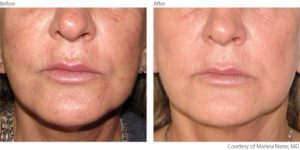 Ask baby boomers today about nutty things they did in the 1960s and 1970s and they’ll likely say they rubbed baby oil all over their teenage bodies before hitting the beach to soak up the sun. Those who were really determined to get the most from the rays even spiked the oil with iodine and used sun reflectors to speed up the process. If only we knew then…
Ask baby boomers today about nutty things they did in the 1960s and 1970s and they’ll likely say they rubbed baby oil all over their teenage bodies before hitting the beach to soak up the sun. Those who were really determined to get the most from the rays even spiked the oil with iodine and used sun reflectors to speed up the process. If only we knew then…

“Sun damage is insidious. You get it from the day you’re born and throughout life, so the more you can protect yourself when you’re young, the better off you’ll be when you reach your 40s and 50s,” said Dr. Mary Lupo, Lupo Center for Aesthetic and General Dermatology in New Orleans. But even if young people in 2019 are more enlightened about protecting their skin than boomers were half a century ago, they often ignore their parents warnings. “Parents can control toddlers and pre-teens. My grandchildren wear sun-protective clothing, sunscreen and hats. But when adolescents and young adults defy their parents and go out in the blazing sun without safeguarding their skin, they’re inviting the sun damage process to begin,” Dr. Lupo explained.
KNOW YOUR A, B, Cs
When you’re soaking up the summer sun, its short Ultraviolet B (UVB) rays hit the top layer of your skin (epidermis) and can cause burns, brown speckling, mottling, and broken capillaries. Unprotected skin can burn in as few as 15 minutes! The longer Ultraviolet A (UVA) rays reach into the skin’s second layer (dermis) and stimulate the melanin (natural pigment), which creates a suntan that makes you glow and look ultra healthy. Ultraviolet C (UVC) rays are the shortest of all and the most dangerous, but fortunately they’re filtered out by the earth’s ozone layer and don’t reach the earth’s surface, or our skin.
Unfortunately, repeated exposure to UVA energy over years accelerates signs of premature aging–think fine lines and wrinkles–by destroying the skin’s collagen and elastin foundation, which decreases its strength, flexibility and suppleness. Called “photoaging,” the consequences also include age spots, freckles, ruddiness from dilated blood vessels, scaly red patches, and tough, leathery skin that feels and looks dry and coarse.
The sun’s UVA rays are just as intense during the winter, and can penetrate the windshield when you’re driving and the living room windows when you’re relaxing on the sofa.
 Sun damage can have medical manifestations, too, such as basal and squamous cell carcinoma, and melanoma, a fatal cancer if not caught and treated early. “And, the sun can damage the immune system cells that live in the dermis and survey for viruses, bacteria and funguses,” Dr. Lupo said. “When your immune system is weakened by the sun, you can develop uncomfortable and unsightly fever blisters.”
Sun damage can have medical manifestations, too, such as basal and squamous cell carcinoma, and melanoma, a fatal cancer if not caught and treated early. “And, the sun can damage the immune system cells that live in the dermis and survey for viruses, bacteria and funguses,” Dr. Lupo said. “When your immune system is weakened by the sun, you can develop uncomfortable and unsightly fever blisters.”
The best line of defense against sun damage is to faithfully shield your skin in the first place, from properly using effective sunscreen year round to driving with the sun visor down, from wearing sun-protective clothing to avoiding sun during the peak hours of 10 am to 4 pm. It’s never too late to start saving your skin, but a number of treatments can mitigate the damage for the millions who already have it. It’s wisest to consult with a dermatologist who will assess your situation and recommend the most effective treatment for you, depending on your type of skin and the severity of the condition.

The following treatments are among those favored by Dr. Lupo and Dr. Gilly Munavalli, Dermatology, Laser & Vein Specialists of the Carolinas. As esteemed dermatologists practicing in warm climates, both have invaluable experience and expertise dealing with sun damage. But even if you live in Minneapolis, the sun’s powerful UV rays can penetrate your car and home windows in frigid temperatures. Most everyone’s skin is a candidate for sun damage. It’s a fact of life.
TOPICAL SKIN CARE FORMULAS
The most abundant antioxidant in human skin, vitamin C (aka ascorbic acid) helps protect skin cells from sun damage. Since our bodies can’t produce it, and derive only a small amount from oral supplements, we can get vitamin C from citrus fruits and dark green leafy vegetables. And  thanks to scientific advances in the beauty industry, it’s available in topical formulas called cosmeceuticals, which are cosmetic products with bioactive ingredients that can help repair damaged skin and prevent further damage.
thanks to scientific advances in the beauty industry, it’s available in topical formulas called cosmeceuticals, which are cosmetic products with bioactive ingredients that can help repair damaged skin and prevent further damage.
Vitamin C cosmeceuticals also promote collagen production to reduce fine lines, and have the potential to thicken the dermis; prompt an anti-inflammatory response in the skin to prevent redness and inflammation even after sun exposure; reduce hyperpigmentation at levels of 5 percent and above, and improve the appearance of sun-damaged skin by strengthening our skin’s ability to repair.
Dr. Lupo likes C+ Correcting Complex 30% from Revision Skincare, which helps brighten and even out the skin tone while protecting the skin from free radicals that can cause skin damage and signs of premature aging. The product is also shown to improve skin firmness. Almost 90 percent of users reported brighter skin and 94 percent saw an improvement in the evenness of their skin tone, according to the company’s website.
Dr. Munavalli likes cosmeceuticals that also include phloretin, a flavonoid (plant pigment) substance that’s derived from apples and apple tree bark. Research has shown that it has antioxidant ability and can improve the appearance of discoloration and overall skin tone. SkinCeuticals Phloretin CF includes 2 percent phloretin, 10 percent pure vitamin C, and .5 percent ferulic acid for protection against premature signs of aging from sun damage and ozone pollution.
CHEMICAL PEELS
Chemical peels can improve the appearance of sun-damaged skin by using a chemical solution to remove the outer layer of old skin. The new skin that replaces is typically smoother and appears less wrinkled. Solutions used include glycolic, trichloroacetic, salicylic, lactic or carbolic acid. During the procedure, patients may experience a burning sensation that lasts five to 10 minutes. The best candidates for chemical peels have fair skin and light hair.
IPL TREATMENTS

Exciting light and laser technologies are changing the face of the beauty business for their ability to safely, gently and effectively treat a wide range of skin conditions. Devices that deliver a broad spectrum of intense pulsed light (IPL), for instance, can reduce sun-induced damage, including sunspots, broken capillaries, fine lines and thickened, dry and wrinkled skin from prolonged and excessive exposure to the sun.
Many dermatologists across the country favor the Lumenis IPL, which lets them adjust pulse duration and wavelength depending on your skin type and what they want to treat. “I’m on my 4th IPL device from Lumenis in the past 20 years. It’s extremely versatile and can target red and brown pigmentation issues, from broken capillaries and ruddiness to sunspots,” said Dr. Lupo. “When the water in the skin absorbs the light energy, collagen renewal is stimulated and patients also see improved skin texture and overall appearance.” Besides their effectiveness, treatments with the Lumenis IPL don’t impose downtime on patients.
IPL treatments for sun damage are more effective in the short and long term than topical formulas, but using topicals after your IPL sessions will help you maintain your skin health and appearance. Each IPL treatment generally takes about 30 minutes, and patients see improvement following the first one. Minor redness and swelling tend to disappear quickly. “Patients usually need three sessions. We’ll go after the pigment during the first treatment and the redness and texture during the second. Then we’ll see what we need to revisit for the final visit,” Dr. Lupo explained.


0 Responses to “Don’t Let Sun Damage Age You Prematurely”
GeekaDB says:
very useful, thank you for this sharing
blepharoplasty tunisia
Sneha Ramesh says:
very useful!